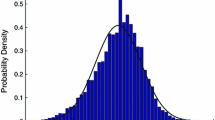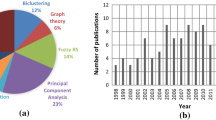Abstract
Neighbor-based collaborative filtering is one of the most practical recommendation approaches that is renowned because of its simplicity and explanation. However, the big limitation is its high computational complexity. It is demonstrated that clustering-based algorithms, that restrict the neighborhood space, speed up the recommendation process at the price of lower accuracy. We propose a new algorithm, called TasteMiner that efficiently learns partial users taste to restrict the neighborhood space. We frame TasteMiner as a method for neighborhood collaborative filtering, and show its effectiveness compared to previous algorithms










Similar content being viewed by others
References
Adomavicius, G., & Kwon, Y. (2012). Improving aggregate recommendation diversity using ranking-based techniques, 1. IEEE Transactions On Knowledge And Data Engineering, 24(5), 896–911.
Alqadah, F., Reddy, C.K., Hu, J., & Alqadah, F.H. (2014). Biclustering neighborhood-based collaborative filtering method for top-n recommender systems, Knowledge and Information Systems.
Bellogin, A., & Parapar, J. (2012). Using graph partitioning techniques for neighbour selection in user-based collaborative filtering. In Proceedings of the 6th ACM conference on Recommender systems (pp. 213–216).
Bobadilla, J., Serradilla, F., & Bernal, J. (2010). A new collaborative filtering metric that improves the behavior of recommender systems. Knowledge-Based Systems, 23(6), 520–528.
Zhou, X., He, J., Huang, G., & Zhang, Y. (2014). SVD-Based incremental approaches for recommender systems. Journal of Computer and System Sciences, 1(3), 1–17.
Satsiou, A., & Tassiula, L. (2014). Propagating users Similarity towards improving recommender systems. IEEE/WIC/ACM International Joint Conferences on Web Intelligence (WI) and Intelligent Agent Technologies (IAT) (pp. 221–228).
Desrosiers, C., & Karypis, G. (2011). A comprehensive survey of neighborhood-based recommendation methods. In Recommender systems handbook (pp. 107–144). US: Springer.
Koren, Y. (2008). Factorization meets the neighborhood: a multifaceted collaborative filtering model. In Proceedings of the 14th ACM SIGKDD international conference on Knowledge discovery and data mining, ACM (pp. 426–434).
Koren, Y. (2010). Collaborative filtering with temporal dynamics. Communications of the ACM, 53(4), 89–97.
Said, A., Kille, B., Jain, B., & Albayrak, S. (2012). Increasing diversity through furthest neighbor-based recommendation. Proceedings of the WSDM.
Dakhel, G.M. (2011). A new collaborative filtering algorithm using K-means clustering and neighbors voting. In 11th International Conference on Hybrid Intelligent Systems (HIS) (p. 179184).
Symeonidis, P., Nanopoulos, A., Papadopoulos, A.N., & Manolopoulos, Y. (2007). Nearest-biclusters collaborative filtering based on constant and coherent values. Information Retrieval, 11(1), 51–75.
Wang, X., Pan, W., & Xu, C. (2014). HGMF: Hierarchical Group Matrix Factorization for Collaborative Recommendation (p. 769778).
Luo, X., Xia, Y., Zhu, Q., & Li, Y. (2013). Boosting the K-Nearest-Neighborhood based incremental collaborative filtering. Knowledge-Based Systems, 53, 90–99.
Symeonidis, P., Nanopoulos, A., & Manolopoulos, Y. (2008). Providing justifications in recommender systems. IEEE Transactions on Systems, Man and Cybernetics, Part A: Systems and Humans, 38(6), 1262–1272.
Symeonidis, P., & Fil, H.I.S.I. (2009). Moviexplain: A Recommender System with Explanations (pp. 317–320): ACM.
Deodhar, M. (2007). A Framework for Simultaneous Co-clustering and Learning from Complex Data. In Proceedings of the 13th ACM SIGKDD international conference on Knowledge discovery and data mining, ACM, (Vol. 2007 pp. 250–259).
Coelho, G.P., & Von Zuben, F.J. (2013). Predicting missing values with biclustering: a Coherence-Based approach. Pattern Recognition, 46(5), 1255–1266.
Saito, T., Kawahara, K., & Okada, Y. (2013). Recommendation method using bicluster network method. In Proceedings of the international multiconference of engineers and computer scientists (pp. 13–16).
Ignatov, D., Poelmans, J., & Zaharchuk, V. (2012). Recommender system based on algorithm of bicluster analysis RecBi. arXiv:1202.2892.
Xu, B., Bu, J., Chen, C., & Cai, D. (2012). An Exploration of improving collaborative recommender systems via user-item subgroups. In Proceedings of the 21st international conference on World Wide Web, ACM (pp. 21–30).
George, T., & Merugu, S. (2005). A scalable collaborative filtering framework based on co-clustering. In 5th IEEE International Conference on data mining, IEEE (pp. 4–12).
Avazpour, I., Pitakrat, T., Grunske, L., & Grundy, L. (2014). Dimensions and metrics for evaluating recommendation Systems. In Recommendation systems in software engineering (pp. 245–273).
Shani, G., & Gunawardana, A. (2011). Recommender systems handbook. New York: Springer.
Leung, K.W., Lee, D.L., & Lee, W. (2011). CLR: A collaborative location recommendation framework based on co-clustering categories and subject descriptors. In Proceedings of the 34th international ACM SIGIR conference on Research and development in Information Retrieval (pp. 305–314).
de Castro, P.a.D., De de Franca, F.O., Ferreira, H.M., & Von Zuben, F.J. (2007). Applying biclustering to perform collaborative filtering. In 7th International Conference on Intelligent Systems Design and Applications ISDA 2007, (Vol. 2007 pp. 421–426).
de Castro, P.a.D., de Franca, F.O., Ferreira, H.M., & Von Zuben, F.J. (2007). Evaluating the Performance of a Biclustering Algorithm Applied to Collaborative Filtering - A Comparative Analysis. In 7th International Conference on Hybrid Intelligent Systems HIS, (Vol. 2007 pp. 65–70).
Newman, M.E.J. (2006). Finding community structure using the eigenvectors of matrices. Physical Review E, 74, 036104.
Zhuang, Y., Chin, W.-S., Juan, Y.-C., & Lin, C.-J. (2013). A fast parallel SGD for matrix factorization in shared memory systems. Proceedings of the 7th ACM conference on Recommender systems - RecSys, 13(0), 249–256.
Herlocker, J.L., Konstan, J.A., Borchers, A., & Riedl, J. (1999). An algorithmic framework for performing collaborative filtering. In Proceedings of the 22nd annual international ACM SIGIR conference on Research and development in information retrieval - SIGIR 99 (pp. 230–237). New York: ACM Press.
Sarwar, B.M., Karypis, G., Konstan, J., & Riedl, J. (2002). Recommender Systems for Large-scale E-Commerce scalable neighborhood formation using clustering. Communications, 50, 158–167.
Author information
Authors and Affiliations
Corresponding author
Rights and permissions
About this article
Cite this article
Shams, B., Haratizadeh, S. TasteMiner: Mining partial tastes for neighbor-based collaborative filtering. J Intell Inf Syst 48, 165–189 (2017). https://doi.org/10.1007/s10844-016-0397-4
Received:
Revised:
Accepted:
Published:
Issue Date:
DOI: https://doi.org/10.1007/s10844-016-0397-4




